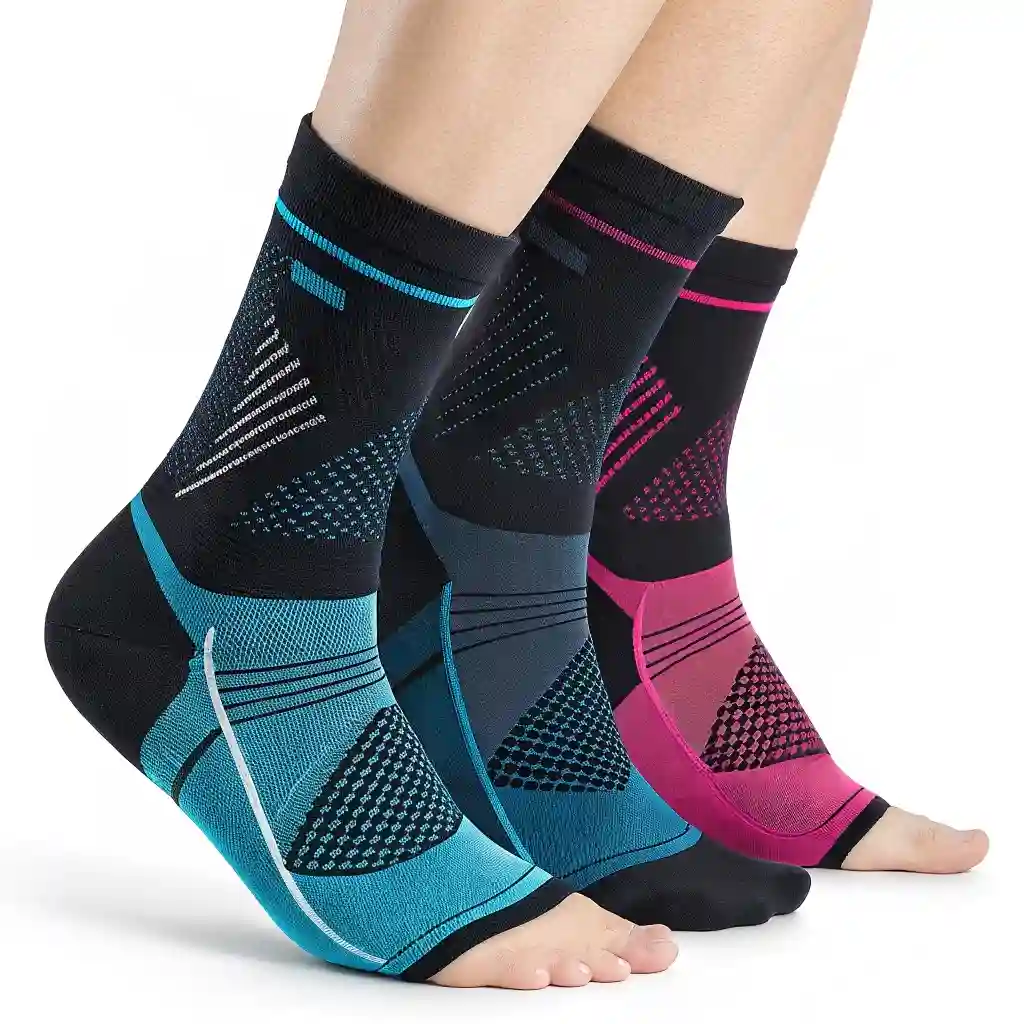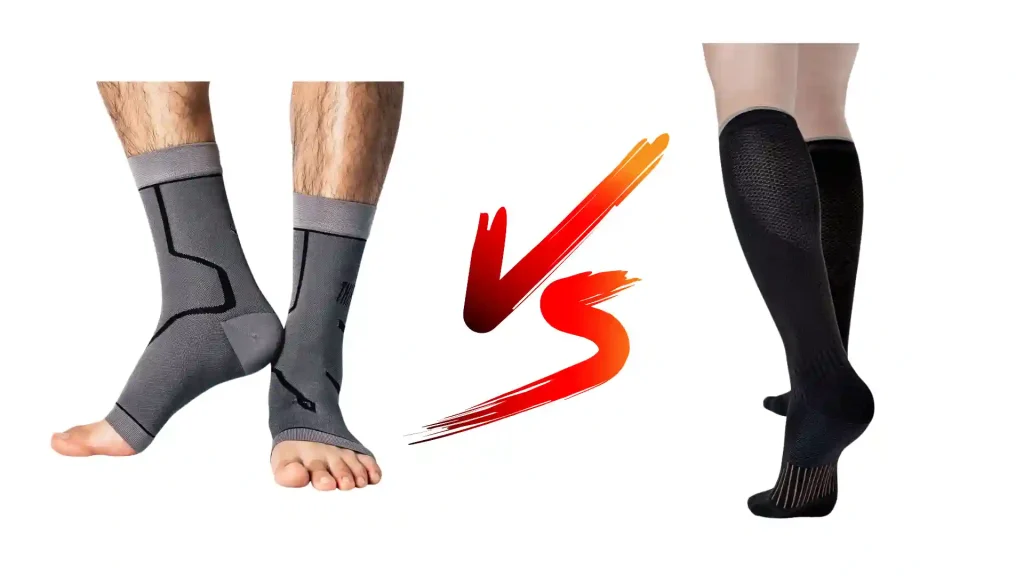Understanding the Customer’s Questions: Why Ankle Compression Socks Are Trending
In today’s market, more and more customers are searching for ankle compression socks—lightweight, comfortable alternatives to traditional knee-high compression socks. Many people experience foot swelling during long runs, extended travel, or long hours on their feet, and they want relief without the full calf coverage that can feel restrictive or uncomfortable.
If your brand or store currently only offers regular compression socks, you might be missing an important segment of buyers who prefer targeted support around the ankle and foot area. Understanding this demand—and offering the right products—can help you tap into new customer groups, reduce returns, and build loyalty.
This article explores why ankle compression socks are gaining popularity, who benefits most from them, and how brands and retailers can add value by including them in their product lineup. We will also compare these socks to regular compression socks and provide tips on how to choose and customize the right options for your customers.

What Are Ankle Compression Socks and Who Benefits from Them?
Ankle compression socks are designed to apply graduated pressure primarily around the ankle and foot, rather than covering the entire calf or lower leg. This targeted compression helps improve blood flow and reduce swelling where it most commonly occurs—around the ankle joint and foot tissues.
People who benefit most from ankle compression socks include:
- Individuals with localized swelling or mild edema mainly in the feet and ankles, often caused by prolonged standing, sitting, or minor injuries.
- Active users and athletes who experience foot fatigue or swelling during running, walking, or other physical activities and prefer less restrictive gear.
- Travelers facing long flights or drives who want effective compression without the discomfort of full-length stockings.
- Office workers and professionals who need comfortable support throughout the day without visible bulky socks.
Unlike knee-high or thigh-high compression stockings, ankle compression socks provide focused relief that fits easily into everyday routines. This makes them an attractive option for customers who prioritize comfort but still require effective compression.
Brands that add ankle compression socks to their lineup can tap into this growing segment, offering a product that meets specific user needs while complementing existing regular compression sock options.
Ankle Compression Socks vs. Regular Compression Socks
When considering compression socks for your customers, understanding the differences between ankle compression socks and regular (knee-high) compression socks is essential. Each serves unique purposes and appeals to different user groups.

Coverage and Compression Focus
- Ankle Compression Socks apply the most pressure around the ankle and foot, gradually easing upwards but stopping below the calf. This localized compression targets swelling and discomfort concentrated in the lower foot and ankle area.
- Regular Compression Socks (usually knee-high) provide graduated compression from the ankle up through the calf, offering comprehensive support for the entire lower leg. They are often recommended for more severe circulatory conditions or for users needing extended venous support.
User Comfort and Preferences
- Many users find ankle compression socks less restrictive and easier to wear daily, especially in warm weather or when full calf coverage feels uncomfortable.
- Regular compression socks provide more extensive support but can feel tighter and less breathable, which might deter some customers.
Ideal Use Cases

- Ankle compression socks are perfect for those who experience mild swelling, foot fatigue, or need light support during daily activities, travel, or light exercise.
- Regular compression socks suit customers with moderate to severe circulation issues, recovery from surgery, or those engaging in heavy physical activity requiring full lower-leg support.
Business Opportunity for Brands
Offering both ankle and regular compression socks expands your product range, enabling you to serve a broader customer base. Brands that provide ankle socks meet the needs of consumers seeking comfort and targeted relief, often encouraging repeat purchases. Meanwhile, regular compression socks cover more medical-grade and intensive use cases.
Understanding these distinctions helps brands and retailers tailor their inventory and market compression socks more effectively, ensuring customer satisfaction and stronger sales.
| Feature | Ankle Compression Socks | Regular (Knee-High) Compression Socks |
|---|---|---|
| Compression Area | Focused on ankle and foot | Covers ankle up to knee |
| Compression Strength | Mild to moderate, targeting localized swelling | Moderate to strong, supporting entire lower leg |
| Comfort & Breathability | Lightweight, less restrictive, suitable for warm weather | More coverage, can feel tighter and warmer |
| Ideal Users | Mild swelling, foot fatigue, travelers, daily wear | Moderate to severe circulation issues, post-surgery recovery, athletes |
| Use Scenarios | Office, travel, light activity | Medical use, intense sports, long hours standing or walking |
| Business Opportunity | Appeals to comfort-focused customers, broadens product range | Covers medical-grade market and serious conditions |
Why Brands Should Add Ankle Compression Socks to Their Product Line
Adding ankle compression socks to your inventory is a strategic move that can help your brand capture emerging market demand and diversify your product offerings. Here are key reasons why B2B buyers should consider these targeted compression socks:
Meet Specific Customer Needs
Consumers increasingly seek comfort and functionality tailored to their lifestyles. Ankle compression socks provide effective swelling relief and support without the bulkiness of full-length socks, making them attractive to office workers, travelers, and light exercisers alike.
Expand Your Market Reach
By offering both ankle and regular compression socks, you cater to a wider audience—from customers with mild foot fatigue to those requiring medical-grade support. This product variety can boost sales and reduce lost opportunities.
Differentiate Your Brand with Customization
Partnering with a reliable compression sock manufacturer enables you to customize designs, materials, and compression levels. Tailored products aligned with your brand identity create stronger customer loyalty and better shelf appeal.
Capitalize on Growing Health Awareness
With rising awareness of circulation health and preventive care, compression socks are becoming everyday essentials. Ankle compression socks provide an accessible entry point for customers new to compression therapy.
Optimize Inventory and Pricing Flexibility
Ankle socks often require less material and simpler production than full-length compression socks, offering competitive pricing and attractive margins. This flexibility supports both budget-conscious and premium market segments.
Key Features and Customization Options for Ankle Compression Socks
To meet diverse customer needs, ankle compression socks come with a range of functional features and customization possibilities. Offering these options helps brands differentiate their products and enhance market competitiveness.
Essential Features
- Graduated Compression: Designed to apply firm pressure at the ankle that gradually decreases upward, promoting healthy blood flow and reducing swelling effectively.
- Moisture-Wicking Fabric: Keeps feet dry and comfortable by drawing sweat away, which is critical for daily wear and athletic use.
- Breathability: Lightweight mesh zones enhance airflow to prevent overheating and discomfort during extended use.
- Cushioning: Targeted padding on the sole or heel absorbs impact and increases wearer comfort.
- Seamless Toe Design: Minimizes irritation and blister risk, ensuring all-day comfort.
- Antimicrobial Treatment: Prevents odor and bacterial growth, important for active users.
Customization Opportunities
- Packaging: Customized packaging enhances brand presence, from eco-friendly boxes to retail-ready blister packs.
- Compression Levels: Brands can select from mild (15-20 mmHg), moderate (20-30 mmHg), to strong (30-40 mmHg) compression to meet various medical or lifestyle needs.
- Materials: Options include nylon-spandex blends, cotton blends, or specialty fibers like merino wool for premium softness and thermal regulation.
- Design and Colors: Custom patterns, logos, and color palettes allow brands to align the socks with their unique identity and target demographics.
Conclusion: Expand Your Product Line with Ankle Compression Socks
Ankle compression socks offer a targeted, comfortable solution for customers dealing with foot swelling, fatigue, and mild circulation issues. They complement traditional knee-high compression socks by meeting a distinct market demand for lightweight, focused support.
By adding ankle compression socks to your offerings, your brand can better serve a diverse customer base, increase sales opportunities, and enhance brand loyalty through customized, high-quality products.
Partnering with an experienced compression sock manufacturer ensures access to a wide range of materials, compression levels, and design options tailored to your brand’s vision and customer needs.
Ready to expand your product lineup with ankle compression socks that combine function, comfort, and style? Contact us today to explore customization possibilities and grow your business with targeted compression solutions.
FAQs
Who should consider wearing ankle compression socks?
Ankle compression socks are ideal for individuals experiencing mild swelling or foot fatigue, travelers, office workers, and active users looking for comfortable, targeted support without full calf coverage.
How do ankle compression socks differ from regular compression socks?
Ankle socks focus compression on the ankle and foot area, while regular compression socks provide graduated pressure extending to the calf or knee. Ankle socks are less restrictive and better suited for light support needs.
Can ankle compression socks help with medical conditions?
They are effective for mild swelling and circulation support but may not be sufficient for severe venous diseases. Customers with serious conditions should consult healthcare professionals and may require higher compression or longer-length socks.
What compression levels are available for ankle compression socks?
Common compression ranges include mild (15-20 mmHg), moderate (20-30 mmHg), and strong (30-40 mmHg). The right level depends on user needs and should be selected with professional advice when medical use is intended.
How can I customize ankle compression socks for my brand?
You can customize materials, compression levels, colors, patterns, logos, and packaging. Working with a factory that offers tailored manufacturing ensures your products align with your brand identity and customer preferences.
